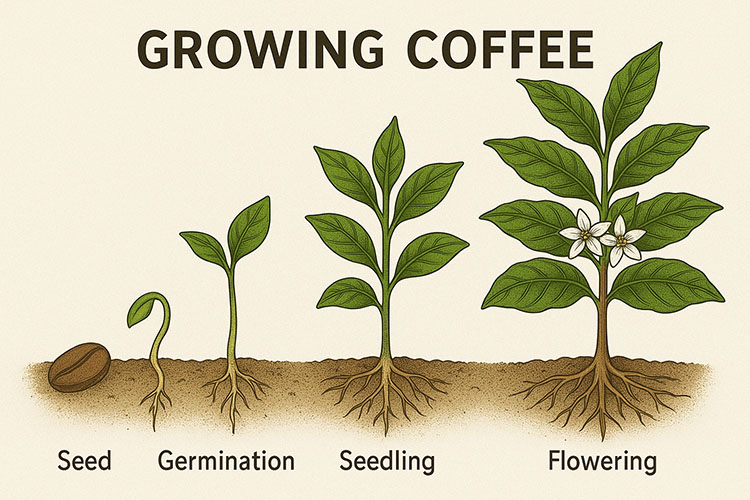Each cup of coffee is more than just a drink — it’s the result of a long and meticulous process that begins long before you press the button on your coffee machine. Let’s follow the journey of a coffee bean from the plantation to your cup.
1. Growing Coffee
A coffee bean is actually the seed of a coffee cherry. Coffee is grown in the so-called “coffee belt” — tropical regions between the Tropic of Cancer and the Tropic of Capricorn. The most well-known coffee-producing countries include Brazil, Colombia, Ethiopia, Vietnam, and Kenya.
Key conditions for a good crop:
- Warm (but not hot) climate
- High altitude (brings more complexity to the flavor)
- Fertile soil and regular rainfall

2. Harvesting
When the coffee cherries are ripe (usually red in color), they are picked either by hand or by machine. Hand-picking is preferred for quality, as only the ripest cherries are selected, which affects the flavor and consistency.
3. Processing Coffee
After harvesting, the cherries need to be processed to extract the green beans. There are two main methods:
- Dry method: whole cherries are sun-dried before the pulp is removed.
- Wet method: the cherries are pulped, fermented, and washed to remove mucilage.
Processing impacts the taste: dry-processed beans tend to be sweeter and fuller-bodied, while wet-processed beans are cleaner and brighter in flavor.
4. Drying and Sorting
Once processed, the beans are dried to the correct moisture level and then sorted by size, weight, and quality. Defective beans are removed to ensure uniform roasting and flavor.
5. Roasting
Roasting transforms green coffee beans into the aromatic brown beans we know. This is when most of the flavor compounds develop — from fruity and floral to chocolatey and nutty.
Main roast levels:
- Light roast — highlights acidity and fruitiness
- Medium roast — balanced sweetness and body
- Dark roast — bolder, bitter flavors with caramel notes
6. Grinding
Before brewing, beans must be ground. The grind size depends on your brewing method:
- Espresso — very fine grind
- Drip coffee — medium grind
- French press — coarse grind
An incorrect grind can negatively affect extraction and taste.
7. Brewing
The final stage is brewing. Whether you use a fully automatic coffee machine, a manual espresso maker, or a pour-over method like V60, brewing technique plays a crucial role.
Tips:
- Measure coffee and water properly
- Use water at 92–96°C (198–205°F)
- Avoid over-extraction (don’t brew too long)
The journey from coffee cherry to your cup is the result of hard work by farmers, processors, roasters, and — finally — you. Each step impacts flavor and aroma. Understanding this process helps you appreciate coffee more and enjoy each sip to the fullest.
